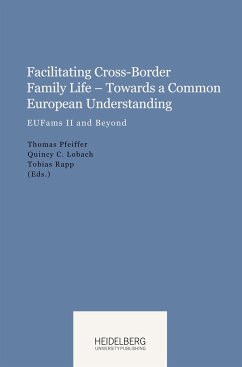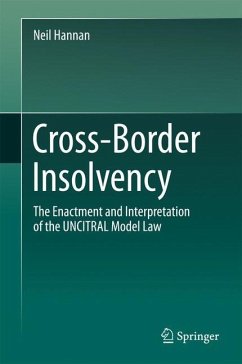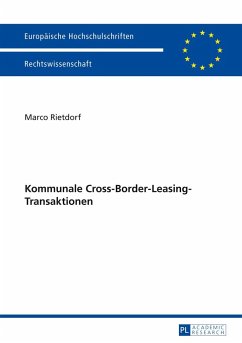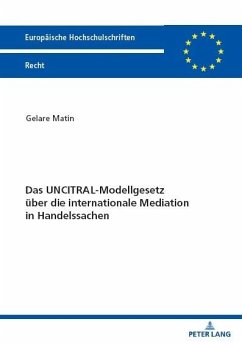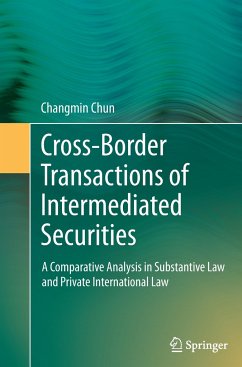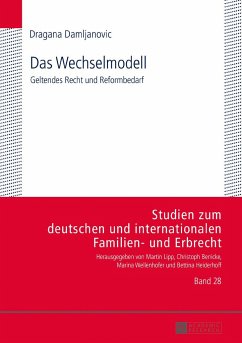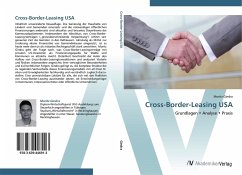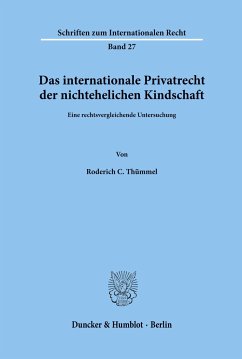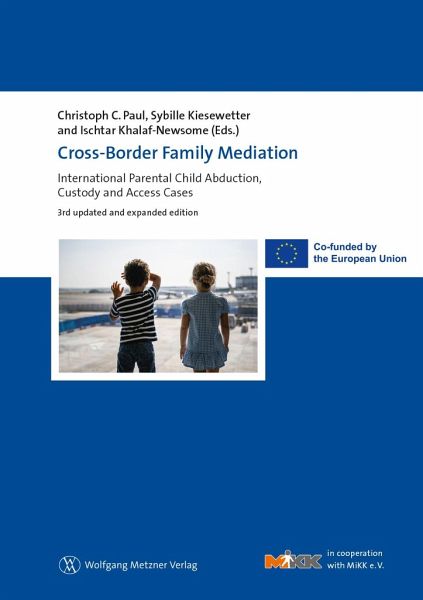
Cross-Border Family Mediation
International Parental Child Abduction, Custody and Access Cases

PAYBACK Punkte
0 °P sammeln!
Die 3. aktualisierte und erweiterte Auflage dieses Werks ist eine unverzichtbare Lektüre für erfahrene Familienmediatoren und alle anderen Fachleute, die mit grenzüberschreitenden Familienkonflikten und Kindesentführungsfällen zu tun haben. Eine Vielzahl von Beiträgen führender internationaler Expertinnen und Experten auf diesem Gebiet machen das Buch zu einer unschätzbaren Quelle, die unter anderem Folgendes bietet: Überblick über den einschlägigen internationalen Rechtsrahmen für solche Fälle Anleitung zu den besonderen Merkmalen grenzüberschreitender Familiensachen sowie den e...
Die 3. aktualisierte und erweiterte Auflage dieses Werks ist eine unverzichtbare Lektüre für erfahrene Familienmediatoren und alle anderen Fachleute, die mit grenzüberschreitenden Familienkonflikten und Kindesentführungsfällen zu tun haben. Eine Vielzahl von Beiträgen führender internationaler Expertinnen und Experten auf diesem Gebiet machen das Buch zu einer unschätzbaren Quelle, die unter anderem Folgendes bietet:
Überblick über den einschlägigen internationalen Rechtsrahmen für solche Fälle Anleitung zu den besonderen Merkmalen grenzüberschreitender Familiensachen sowie den eingesetzten Methoden, Mediationsmodellen und Instrumenten Informationen zur Koordinierung der Mediation mit Gerichtsverfahren in Kindesentführungsfällen Leitlinien für die grenzüberschreitende Vollstreckbarkeit von im Mediationsverfahren geschlossenen Familienvereinbarungen Ansätze und bewährte Praktiken für die Mediation in Fällen mit (muslimischen) Ländern, die nicht dem Haager Übereinkommen angehören Informationen zur Einbeziehung der Stimme des Kindes in die Mediation, Online-Mediation, Zweisprachigkeit in der grenzüberschreitenden Mediation praktische Informationen und Ressourcen wie z.B. Fallstudien, Muster für Mediationsvereinbarungen und Gerichtsbeschlüsse, eine Vorlage für eine Gerichtsstandsvereinbarung, Checklisten, Links wichtiger Ansprechpartner und Texte der anwendbaren internationalen Rechtsinstrumente
The 3rd updated and expanded edition of this reference book is indispensable reading for experienced family mediators and all other professionals involved in cross-border family conflicts and child abduction cases. A diverse range of contributions from leading international experts in the field make this an invaluable resource covering:
an overview of the relevant international legal framework for such cases insight into the specific characteristics of cross-border family cases, the methodologies, mediation models and tools employed information on coordinating mediation with court proceedings in child abduction cases guidance on the cross-border enforceability of mediated family agreements family law trends and mediation in cases with non-Hague Convention (Muslim) countries the voice of the child, mediating online, bilingualism in mediation practical information and resources, such as case studies, sample mediation agreements and court orders, a template of a choice of court agreement, checklists, important contacts and applicable legal texts
List of authors
Lin Adrian, Lesley Allport, Charlotte Baek Risbjerg, Sabine Brieger, Eberhard Carl, Mary Carroll, Martina Erb-Klünemann, Juliane Hirsch, Mohamed M. Keshavjee, Ischtar Khalaf-Newsome, Sybille Kiesewetter, Kyra Nehls, Christoph C. Paul, Jamie Walker, Konstanze Welz
Überblick über den einschlägigen internationalen Rechtsrahmen für solche Fälle Anleitung zu den besonderen Merkmalen grenzüberschreitender Familiensachen sowie den eingesetzten Methoden, Mediationsmodellen und Instrumenten Informationen zur Koordinierung der Mediation mit Gerichtsverfahren in Kindesentführungsfällen Leitlinien für die grenzüberschreitende Vollstreckbarkeit von im Mediationsverfahren geschlossenen Familienvereinbarungen Ansätze und bewährte Praktiken für die Mediation in Fällen mit (muslimischen) Ländern, die nicht dem Haager Übereinkommen angehören Informationen zur Einbeziehung der Stimme des Kindes in die Mediation, Online-Mediation, Zweisprachigkeit in der grenzüberschreitenden Mediation praktische Informationen und Ressourcen wie z.B. Fallstudien, Muster für Mediationsvereinbarungen und Gerichtsbeschlüsse, eine Vorlage für eine Gerichtsstandsvereinbarung, Checklisten, Links wichtiger Ansprechpartner und Texte der anwendbaren internationalen Rechtsinstrumente
The 3rd updated and expanded edition of this reference book is indispensable reading for experienced family mediators and all other professionals involved in cross-border family conflicts and child abduction cases. A diverse range of contributions from leading international experts in the field make this an invaluable resource covering:
an overview of the relevant international legal framework for such cases insight into the specific characteristics of cross-border family cases, the methodologies, mediation models and tools employed information on coordinating mediation with court proceedings in child abduction cases guidance on the cross-border enforceability of mediated family agreements family law trends and mediation in cases with non-Hague Convention (Muslim) countries the voice of the child, mediating online, bilingualism in mediation practical information and resources, such as case studies, sample mediation agreements and court orders, a template of a choice of court agreement, checklists, important contacts and applicable legal texts
List of authors
Lin Adrian, Lesley Allport, Charlotte Baek Risbjerg, Sabine Brieger, Eberhard Carl, Mary Carroll, Martina Erb-Klünemann, Juliane Hirsch, Mohamed M. Keshavjee, Ischtar Khalaf-Newsome, Sybille Kiesewetter, Kyra Nehls, Christoph C. Paul, Jamie Walker, Konstanze Welz




